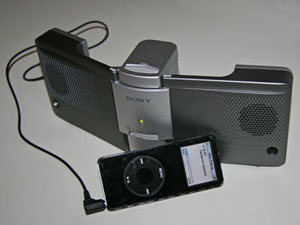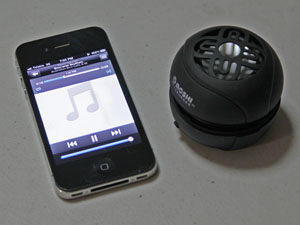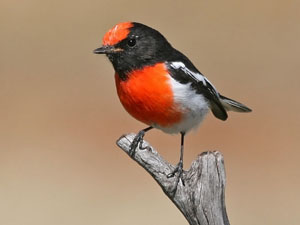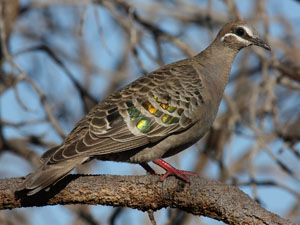Using Bird Calls for Photography
by Keith Lightbody 22 Oct 2012
CAUTION: Bird welfare must take priority over observation and photography.
For sound advice on ethical bird watching please visit BirdLife Australia to download the Ethical Birding Guidelines http://www.birdlife.org.au/documents/POL-Ethical-Birding-Guidelines.pdf
Using bird calls with an mp3 player and a mini portable speaker system also frequently allows me better opportunities for bird photography. One method I use is to play the call of the bird while I approach slowly and indirectly with my camera hand held - with slow steps, pauses and careful monitoring - usually the birds are much less likely to take flight. The other method I use is to set up my camera on a tripod at an acceptable distance to the bird from a suitable perch. The birds are then attracted by placing the bird call player near the perch. With a Bluetooth speaker this can be done without leaving a bird call playing repeatedly.

mp3 player and external speakers
("old technology")

smartphone and $70 Bluetooth speaker
(no cables plus 10 metre range!!)
I can only imitate a few bird calls well so I find using a portable music player with recorded bird calls and external speakers is very helpful for my photography. The use of Bluetooth speakers is far superior - at any stage you can vary the recording without going near the speaker (or the curious bird).
.............................
Bird call systems can attract some curious or social birds right up to the speakers (e.g. fairy wrens, thornbills, silvereyes) while some other birds completely ignore the sounds. NOTE: Do not play bird alarm calls within the hearing range of birds. I usually place the speakers in a low bush or tree similar to one that the bird has recently occupied. Careful selection of sites is required to allow for sunlight to shine on the birds from behind the photographer. You also need to think like a bird to identify branches that the bird is willing to land on and think like a photographer to identify a simple perch in clear view with no distracting background.
Stop using a call if a bird is not comfortable (when I was learning a rufous whistler flew down and bumped my system out of a tree). However I have had another case where a splendid fairywren sat on my phone playing its call while I was less than a metre away! Bird calls seem to work better with some species but it also depends on the type of call, the time of the year and how close you are to the bird. NOTE: BirdLife Australia Ethical Birding Factsheet advises to avoid call playback during nesting season. It is usually more effective to stalk without staring at a bird or walking directly towards it. I have found many of the bird calls from David Stewart’s Australian Bird Call CDs http://www.naturesound.com.au/ very useful as they include other species in the background. This seems to keep the birds relaxed and often results in me photographing additional bird species in the same location.
The release in 2011 of Michael Morcombe’s eGuide to Australian Birds as an app available for download for Apple or Google Android devices has dramatically increased the number of bird calls available. It is also a "must have" for any serious birder - apart from listening to the different bird calls to help with identification, some extra calls are available e.g. male, female, juvenile, alarm or feeding calls. In addition you have distribution maps, multiple images of each species and notes. Choosing from the My Location menu keeps the number of birds more manageable. I highly recommend this eGuide - my copy has been worth every cent!
* there is also a
free trial version of the Michael Morcombe bird app *
https://itunes.apple.com/au/app/michael-morcombe-eguide-to/id539890367?mt=8
Hundreds of Australian bird calls fit on basic Windows MP3 players or Apple iPods. The iPod allows very fast scrolling through all the bird calls by circling the dial with your finger. Smart phones can be even better as it saves having a second device for bird calls. My bird calls are sorted alphabetically by type i.e. all honey eaters, all parrots, all ducks, etc are grouped together. This is done by editing the file names before loading e.g. Owl Barking, Owl Barn, etc. I have done the same for my iPhone but it also has hundreds more calls from Michael Morcombe's eGuide to Australian Birds. Scrolling on the iPhone requires a repeated flicking or pushing action.
In quiet conditions you can use just an iPhone which actually has 2 small speakers in the base. I can often get the birds to hear the calls by simply holding my iPhone (with the speakers facing out) under my lens while I am stalking. For longer distances or louder volumes I plug in external speakers. I highly recommend the Bluetooth speaker option - it allows you to stop, start, switch type of call or even switch species. Wireless Bluetooth speakers allow you to minimize any impact on the birds. The Moshi Bassburger even comes with a little bag - add a piece of string and it is easy to hang in a suitable bush or tree at a height that the bird frequents.
Alternatively when it is windy or the trees are tall I can still play calls back louder on the external Sony speakers (~AU$90) which are powered by 4 AA batteries. It is worth buying top quality, long lasting Sony, Duracell, Energizer or similar alkaline batteries (~$10) – my Sony batteries lasted for 6 months. You can probably fit all the bird calls of the world on a single mp3 player plus still have room for your music collection!
It is important when you are purchasing bird calls for use in the bush that they are without music or spoken commentary as this avoids any need for time consuming sound editing. Make sure each bird call is clearly labelled on your MP3 player as the complete list can also be used to aid species identification e.g. you may see or hear a wood swallow in the distance - a quick listen to each of the different wood swallow calls may help confirm your sighting.
One of my first bird call attempts at Mt Brown overlooking York in April 2008. After a while the male red capped robin sat on a stick I had placed in a clearing near the speakers. Note: there is no distracting background.

Some people can mimic bird calls with great skill e.g. http://www.worldamazingrecords.com/2008/07/mimic-151-different-types-of-birds.html )
Bird calls can be mimiced by:
-
using your mouth
http://www.worldamazingrecords.com/2008/07/mimic-151-different-types-of-birds.html
- using an instrument
- using a piece of gum leaf inside the mouth
-
playing a recorded bird call using a portable music player and mini speakers
Things to consider:
- use of a predators call could cause a species to vacate the area
-
the use of recordings and other methods of attracting birds should be limited
- avoid attracting threatened, endangered or rare birds
- limit or avoid the use of bird calls
in heavily birded areas
- most smartphones or mp3 players are suitable
for bird calls
(but check for BlueTooth support if you wish to use wireless speakers)
- cheap mp3 players work fine: an expensive smart phone is nice but not essential
Playing the bird calls is very helpful when I am approaching a bird e.g. the Bronzewing photo was taken while in the company of 2 friends. Note: it normally would have flown away.

Some helpful links:
PLEASE NOTE: before using bird calls read Ethical Birding Guidelines at top of this page
Michael Morcombe's eGuide to Australian Birds
http://www.michaelmorcombe.com.au/
David Stewart’s Australian Bird Call CDs
http://www.naturesound.com.au/
Identifying and Interpreting Bird Calls and Behaviors
http://www.wildernesscollege.com/bird-calls.html
Australian Bird Calls
http://www.abasales.com/index.php?main_page=product_info&products_id=995
Song Birds of India
http://www.birdcalls.info/
Recording bird calls
http://www.naturesongs.com/
Alan Murphy's new eBook The Photographers Guide to Attracting Birds
http://www.alanmurphyphotography.com/ebook.htm
Site credit: These notes were originally inspired by my observation of Dr Eric Tan using a MP3 player while photographing birds at Lake Preston. At one stage the fairy wrens actually sat on the speakers! First published 25 Dec 2008. Feedback is welcome.
More of my photos are available at
http://www.zardec.net.au/keith/photos.htm
My email: